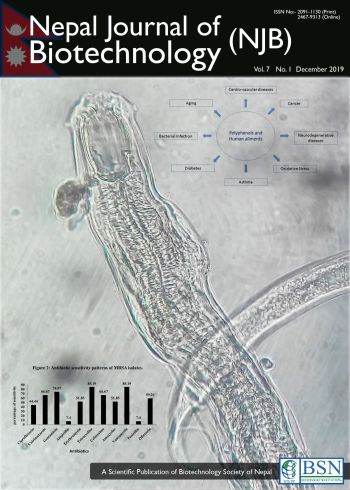Detection of Pyuria by Microscopic Urinalysis as a Marker of Pediatric Urinary Tract Infection
DOI:
https://doi.org/10.3126/njb.v7i1.26946Keywords:
febrile, marker, microscopic urinalysis, pediatric, pyuria, UTIAbstract
Globally, different diagnostic tests of urinary tract infection (UTI) are in clinical practices. A reliable test can increase the efficiency of the healthcare system, especially in a developing country like Nepal, reducing cost and time. Thus, we accessed the possibility of pyuria detected by microscopic urinalysis as a marker of pediatric UTI. The prospective study was conducted fromJuly2014 to January 2015 at Alka hospital, Lalitpur. Microscopic urinalysis of 353clean-catch urine samples was done by the wet mount method, followed by urine culture by a semi-quantitative method. We confirmed 64 (18.1%) UTI cases by culture, the gold standard for UTI diagnosis. Fever was the most common clinical manifestation in UTI cases. The sensitivity, specificity, positive predictive value and negative predictive value of pyuria detected by microscopic urinalysis to identify UTI were 50%, 70.9%, 27.6% and 86.5% respectively. In 318 febrile cases, the sensitivity, specificity, positive predictive value and negative predictive value of pyuria detected by microscopic urinalysis to identify UTI were 73.2%, 72.6%, 28.3% and 94.8% respectively. The findings suggest pyuria detected by microscopic urinalysis as not a worth while marker of pediatric UTI. But it is a trust worthy marker in febrile pediatric cases.
Downloads
Downloads
Published
How to Cite
Issue
Section
License
Copyright Notice:
The manuscript submitted to NJB must be an original contribution, not previously published and should not be under consideration for publication elsewhere. When the manuscript is accepted for publication, the authors agree to automatically transfer the copyright of the article to the publisher. It should grant permission to any third party, in advance and in perpetuity, the right to use, reproduce or disseminate your article, according to the NJB copyright and license agreement.
Authors transfer copyright to the publisher as part of a journal publishing agreement but have the rights to: Share their article for Personal Use, Internal Institutional Use and Scholarly Sharing purposes, with the NJB applies the Creative Commons Attribution-NonCommercial CC BY-NC license to all the works we publish after Jun 2020 (Before it was CC BY-NC-ND). Under this license, authors agree to make articles legally available for reuse, without permission or fees, for virtually any non-commercial purpose. Anyone may remix, adapt, and build upon your work non-commercially, and although their new works must also acknowledge you and be non-commercial, they don’t have to license their derivative works on the same terms. More details on CC BY-NC refer to its Licence Deed and Legal Code.






